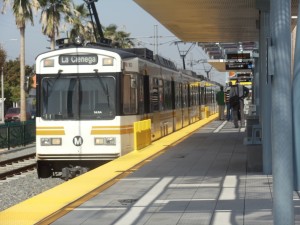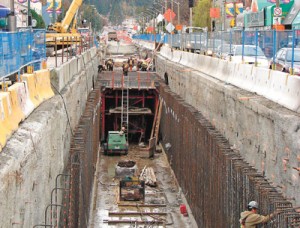In the hand-wringing over the Expo Line to Santa Monica’s slow travel times, Kerry Cavanaugh of the Los Angeles Times argues that transit like Expo shouldn’t have to deal with automobile traffic:
The long-term answer, however, is grade separation. Trains can run faster and more safely and stay on schedule if they don’t have to cross paths with drivers, pedestrians and cyclists. (KPCC-FM (89.3) analyzed Metro data and found that, no surprise, the underground subway lines have the fewest delays.)
Of course, it’s more expensive to build grade-separated rail or to retrofit an existing system. An overpass can cost as much as $20 million, one official estimated. But as L.A.’s rail system expands in an increasingly dense, traffic-clogged urban area, it’s penny-wise and pound-foolish to build lines that have to stop at red lights and share the road with cars.
She rightly points out that these trains should also have signal priority to avoid getting stuck at red lights.
It’s obviously a better deal to have grade separation in terms of reduced travel times — and it’s much safer for pedestrians and other drivers as well, not to mention for the transit riders in the train cars that get hit.
 But the problem with grade separation, as Cavanaugh acknowledges, is that it’s very expensive to build lines that run above or below street level. And retrofitting the newly opened Expo Line to either trench the line through downtown Los Angeles or go aerial is essentially infeasible at this point. First, it would cost money that Metro doesn’t have. And second, it would require essentially mothballing the existing train line in whole or in part for a few years during construction.
But the problem with grade separation, as Cavanaugh acknowledges, is that it’s very expensive to build lines that run above or below street level. And retrofitting the newly opened Expo Line to either trench the line through downtown Los Angeles or go aerial is essentially infeasible at this point. First, it would cost money that Metro doesn’t have. And second, it would require essentially mothballing the existing train line in whole or in part for a few years during construction.
This same challenge is evident in the calls to convert the Orange Line busway in the San Fernando Valley to light rail. If the construction upgrade happens, the busway will be out of service, causing a major headache for transit riders.
The best solution is to simply build the best line from the start. And given that transit funds are scarce in a region as big as Los Angeles, that means focusing on low-cost solutions like signal priority and the ability to close down under-performing stations to speed up travel for everyone else, or double-tracking parts of the line to allow express trains to pass slower ones (which may be cheaper overall than grade separation).
Demanding grade separation in new projects is a good idea, but even then transit advocates will likely have to compromise it away in the name of fiscal responsibility. So they should think through low-cost but effective backup plans early on to ensure speedy and reliable service.
Leave a Reply
You must be logged in to post a comment.



